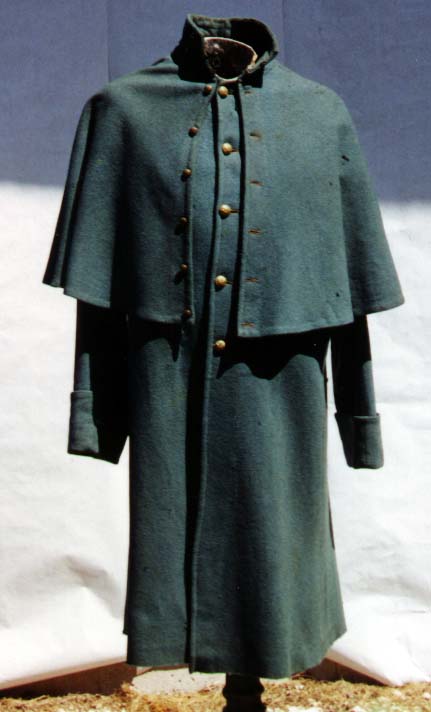Posts: 24 Location: Saugus, MA
Thu 04 Dec, 2008 1:46 pm
Hi Rondolfo,
The coat in the picture is a US regulation issue enlisted infantryman's overcoat. It is made of sky-blue kersey wool, is single breasted, has an elbow-length cape, and a stand-up collar. The regulation mounted service (cavalry, mounted artillery, and horse artillery) enlisted overcoat is also made of sky-blue kersey, but is double breasted, has a wrist-length cape, and a stand-and-fall collar.
Officer's overcoats were of a style called a "boat cloak." They were dark blue, closed with black silk frogs over toggles, had black silk gallooning on the sleeves to indicate rank, and frequently had the cape lined in the branch color (black for staff and general officers, sky blue for infantry, red for artillery, and yellow for cavalry). There was more variation in the style of officer’s coats since they purchased them privately. Later in the American Civil War, the regulations allowed officers to wear the enlisted mounted services coat since distinctive displays of rank attracted sniper fire. This was the same reason the later regulations allowed small rank insignia on the collar in lieu of shoulder boards or epaulettes.
The Confederate regulations specified an overcoat, but no coats were ever procured or issued to those regulations. Confederate troops wore pre-war militia coats, privately procured coats, or captured coats. Obviously, wearing captured uniforms presented a problem and one general proposed dying them black before issuing them. Most Confederate troops were never issued an overcoat at all.
Federal uniforms were loosely based on contemporary French uniforms, but caped overcoats had gone out of fashion in the French army by that time. They also occur occasional in civilian fashion, and in Great Britain in a form know as an Inverness. The Metropolitan Police in London wore caped overcoats in the 19th century, too. I’m going to check the reference to Canadians Zouaves in Papal service since French Zouaves were not issued overcoats. Zouaves and Turcos instead wore a distinctive hooded short cape called a talma.
Caped overcoats are a traditional military uniform in the United States. The US Military Academy adopted them in 1828 and cadets still wear them today. Following USMA’s lead, a number of military schools and academies use them too. That may explain why they remained in use in the US long after they went out of fashion in the rest of the world.
The US 1861 Regulations, including the uniform regulations, are on-line at Google books:
http://books.google.com/books?id=yQ1CAAAAIAAJ...egulations
Best Regards,
Paul
